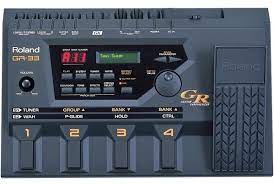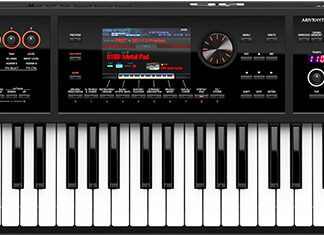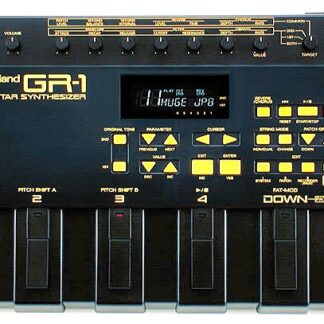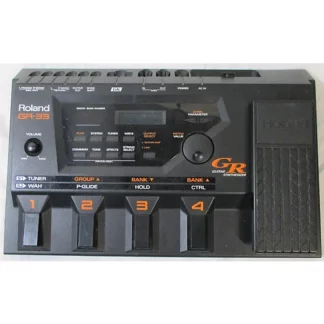Description
Roland GR33
Roland’s new guitar synth is their most affordable yet, but could it also be the best?
While most manufacturers have all but given up on guitar synthesis, Roland have demonstrated an admirable degree of tenacity in this area, and given that our surveys indicate that around half the UK’s project studio owners play guitar as a first instrument, this is definitely good news for SOS readers. Over the past few years, Roland have launched some very affordable and surprisingly playable models including the GR09 and the GR30 (reviewed back in SOS May ’94 and February ’97 respectively), but their new GR33 is both the most sophisticated and the least expensive guitar synth they’ve ever built.
Retailing at just under £500, the GR33 is based around the JV sound engine, as used in Roland’s popular JV1080 and JV2080 synths, giving this GR a far better sound quality than previous ones, which used sounds derived from more basic Sound Canvas sound sets. Although the GR33 isn’t expandable by means of cards like other instruments in the mainstream JV range, its waveforms have been selected from a number of different JV sound sets in order to provide the guitarist with a wide tonal palette. As with other JV instruments, a comprehensive multi‑effects section is included.
Hardware
The GR33 is designed as a floor unit for both live and studio use and must be used in conjunction with a Roland GK2A divided pickup or one of its licensed equivalents (note that this is not included in the GR33’s £499 price tag, Roland’s logic being that many prospective GR33 purchasers will already have one from their previous system). This pickup derives a separate signal from each guitar string and sends these signals to the circuitry that analyses the string pitch and then drives the synth section. You can use sticky pads to affix the pickup, but I’ve always found that it needs to be screwed firmly to the guitar for the best results, and with the new mounting bracket for the GK2A’s control box, which uses the guitar’s strap peg, there’s now even less of a reason to use adhesive pads and risk damaging your guitar’s finish.
The GR33 features a full LCD display along with an integral pedal that can be assigned to a number of real‑time control functions on a per‑patch basis — volume, rotary speed, auto‑harmony level and so on. In addition, there are the four familiar footswitches that can be switched between two modes using the S1 and S2 buttons on the GK2A control box. In one mode the switches are used for sound selection (Groups, Banks and Patches) while in the other they provide real‑time control inputs for wah, pitch glide, hold effects and other controllers. As the wah and glide effects are controlled here by on/off switches rather than variable pedals, the software provides for a choice of rise and fall times.
The physical controls on the front panel have been kept as simple as possible while still offering a sensible degree of editability to the sounds. In addition to volume and data knobs, there’s just a handful of buttons, a three‑digit LED window and a two‑line backlit LCD window. Two Peak/Parameter buttons above the data wheel act as cursor key while a single button below the display switches from PA to guitar amp mode. In PA mode, the output is untreated, just as it would be from a keyboard, but in guitar amp mode, the synth output is EQ’d so as to sound reasonably accurate when played via a guitar amp. This is a useful feature for those live players who don’t have the luxury of a separate amp for their synth.
Editing
The eight main buttons are arranged in two rows of four. The upper four are Play, System, Tuner and Write. Play mode is used when you’re playing rather then editing or tweaking, and System lets you set up global parameters, such as the string sensitivity. Tuner turns the display into a very accurate guitar tuner that automatically recognises which string you’re tuning up, and Write is used to save patches you’ve created or edited.
 The built‑in pedal is an invaluable means of adding expression simply and quickly.
The built‑in pedal is an invaluable means of adding expression simply and quickly.
The lower four buttons, Common, Tone, Effects and String Select, all deal with sound editing. The GR33 has 384 waveforms or Tones stored in ROM, and a Patch can make use of either one or two Tones. The maximum polyphony is 48 voices (one voice is required to play one Tone), and in addition to the 128 factory patches, there’s RAM space for a further 128 user sounds. Sound editing overall is much simpler than on an ordinary synth, so instead of full ADSR envelope control, each sound comes with a preset envelope where the default attack and release settings can be increased or decreased by the user via just two parameters. Similarly, the usual filter controls are replaced by a Brightness parameter. Other then those very basic tweaks, you can adjust the balance between the two Tones and also detune them by two preset amounts. Any further sound design has to be undertaken by adding effects.
You use the Tone button to set up which tone or pair of Tones is to be used for your patch, and parameters that all Patches have but which can be different in each Patch are grouped under the Common button. It’s here, therefore, that you set up individual user patch names, and access the parameters necessary for setting the patch‑specific functions of pedals and controllers. The picking style can be set on a per‑patch basis, and as well as hard, normal and soft, there are finger‑style, tapping and fixed‑level modes as well as two other options that allow the guitar note envelope to be imposed upon the synth sound. There’s also another set of picking modes with the prefix ‘Accl’ (Acceleration) that provide even faster tracking at the expense of some ‘noise’, for use by more experienced guitar synth players. I found these ‘Accl’ modes produced slightly less clean tracking with my playing, and as the response is so fast in standard mode, I didn’t really find a use for them.
As with most guitar synth systems, when you first get going with the GR33, each guitar string controls its own sound generator on a separate MIDI channel, as this allows independent pitch‑bending by bending the guitar strings, but there’s also a simpler Poly mode that can be used where independent pitch‑bend is not required. For instruments such as Piano and Organ that don’t have natural pitch‑bend at all, a patch can be set to Chromatic mode, where pitch‑bend is ignored. There are actually three different chromatic modes which deal with hammer‑ons either by omitting them, playing them at the volume of the original note or playing them at the volume level of the hammer‑on itself. These modes can also be optimised per patch so you can get the right feel for each sound called up.
Because each string outputs data on its own MIDI channel, different sounds can be assigned to different strings. For example, one of the factory patches has a fixed‑pitch digeridoo drone triggered by the bottom string, with some kind of ethnic flute on the other five. It’s also possible to transpose the sounds assigned to different strings so that different tunings can be created without retuning the guitar. All six strings can also be given independent tunings if necessary.
The Hold footswitch offers three different modes. The first is Damper Hold/Damper, allowing existing sounds to be sustained while playing continues. Sostenuto Hold/Sostenuto freezes the synth sounds currently playing and doesn’t permit any new sounds to be played. String Hold/Sostenuto also freezes any currently sounding voices, but still allows you to play new parts on any strings that weren’t being used at the time you pressed Hold. Once again, these settings can be saved with user patches.
The effects section comprises chorus, reverb and a multi‑effects block, and if the synth Tone editing parameters are very basic, the effects section is anything but. Here you can choose from 40 different multi‑effect types, ranging from flanger plus delay to enhancer, and some of the effects allow quite detailed editing if you so choose. Also included in the effects menu is an auto‑harmony feature where you set a key (major or minor plus root note) and a harmony interval. Once set, the synth creates a real‑time harmony for you that can be played on either or both of the Tones in the patch, and the pedal may be set to fade in the harmony part during a performance. It is possible to transmit the harmony data over MIDI, but you can’t send the original note plus the harmony at the same time, which is rather a shame — you have to choose one or the other. Even so, if you record the original notes to a sequencer, then play these back into the GR33 set to a suitable harmony patch, the harmony will be recreated by the GR33 during playback.
There’s also an arpeggiator that offers a number of preset picking patterns, and as well as the usual up/down keyboard‑style arpeggiation, you get variations that are supposed to sound like guitar finger‑picking (one sounds suspiciously like ‘Hotel California’…). The arpeggiator data can be output via MIDI and the tempo may be controlled manually or set via a tap‑tempo facility with the pedal, but there’s no MIDI sync, which means that although you can record the arpeggio into a sequencer track, you can’t expect it to stay in time with your click track.
Making Connections
 The interface for the GK2A pickup needed to drive the GR33, with built‑in controls for accessing the two different modes. The unit can be firmly mounted, without damaging the guitar’s finish, using the strap peg, as shown.
The interface for the GK2A pickup needed to drive the GR33, with built‑in controls for accessing the two different modes. The unit can be firmly mounted, without damaging the guitar’s finish, using the strap peg, as shown.
The GR33 unit has ordinary quarter‑inch, unbalanced jack outputs for the left and right synth outputs, plus a further output jack for the normal guitar pickup (you connect the normal output from your pickup to the GK2A, which relays it to the GR33 itself; this saves having two cables dragging across the floor). If the separate guitar out isn’t needed, the guitar sound can be mixed with the synth outputs, and where a stereo amp isn’t available, the Right jack can be used on its own to provide a mono output. The left jack also doubles as a stereo phones output. There’s also another pair of jacks labelled Guitar Return which can be used in combination with the Guitar Out jack to provide a mono‑send/stereo‑return loop for the synth sound.
Although the GR33 can be controlled pretty effectively from its own switches and pedal, there is provision for connecting external Bank footswitches — one for up and one for down — using a pair of Boss FS5U footswitches or equivalents. The MIDI In and Out are quite standard, as is the GK pickup DIN connector, and power comes from an included mains adaptor.
The GR33 can even be used as a master controller; you place it in Local Off mode by powering up with the Play button held down. However, it defaults to Local On when the machine is next switched on, unless Play is again held.
Using The GR33
Careful setting up of the GK2A divided pickup, with particular attention to its height relative to the strings, is essential if the guitar synth is to behave properly, so it’s a good idea to at least read this part of the manual! It’s also important not to have too low an action set on the guitar as this can cause tracking problems, as fret buzz can trigger spurious notes. Once the pickup and string sensitivities are set up as described in the manual, the GR33 is ready to go, and the tracking response time is extremely fast. I found that I had to play fairly carefully to prevent new notes being triggered when I lifted my fingers from the strings on some occasions, but this problem can be avoided by either damping the strings with the right hand or using the Hold footswitch. Even so, I feel that an additional ‘threshold’ parameter would have helped in this respect. As it is, you only really have the string‑sensitivity parameter to play with.
The playability of the GR33 is similar to that of its most recent predecessors with the exception of the tracking delay, which seems to have been improved to the point where you can pretty much forget about it. Using a tremolo arm doesn’t seem to worry the machine either, but as with any guitar synth, you have to meet it halfway when it comes to playing technique. It’s not so much a matter of learning new techniques but rather remembering to avoid the standard guitar tricks that might cause problems, specifically ‘digging in’ to get harmonics, or fast, sloppy hammering. If you play cleanly and phrase your parts with regard to the sound being used, you can get great results with very little effort. It’s also worth getting used to employing the Hold footswitch to control sustained notes or chords.
The sounds themselves are comparable with what you’d expect from a JV1010 module, but the choice of Tones is different; these appear to have been gleaned from the various JV expander cards, providing a flexible set suitable for guitar control. There’s a good selection of mainstay sounds, like organs, pads, pianos, synth leads and brass plus some really nice bass sounds, both overtly synthetic and ‘real’. There’s even a selection of guitar sounds, including a pedal‑steel patch that sounds surprisingly authentic when played with the harmony facility, but being realistic, I think most guitar players would rather get their guitar sounds from their guitar. There are quite a few ethnic sounds, including flutes, tablas, sitars, shamisens and so forth, and tucked away at the end of the list are some unusual effects, including the uncannily real (and surprisingly usable) ‘human drums’. More conventional drum sounds are included for those who prefer to play drums from a guitar rather than from a keyboard.
Good though the factory patches are, there are lots of interesting Tones that aren’t used amongst the presets, and because editing sounds is so simple, it takes no time at all to run through them and knock up a few patches of your own. There’s even a nod in the direction of earlier guitar synths with ‘GR Strings’ and ‘GR300 Lead’.
The JV sound engine has a much clearer, quieter sound than the previous Sound Canvas engine and its only weakness (relative to ordinary JV modules, anyway) is its lack of expandability. Given that guitar synths always track best when used with their internal sounds, perhaps there’s an argument for a more upmarket ‘pro’ model with JV‑type expansion slots.
The integral pedal is very useful as it can be programmed specifically for each user patch. Many of the factory patches make really good use of the pedal and it’s particularly effective when used to control the rotary speed on some of the organ patches, or when used to bring harmonies in and out on patches that use that feature.
The arpeggiator works well in conjunction with the Hold footswitch and succeeds in recreating the traditional synth arpeggiator sound, but I found it less convincing for emulating guitar finger‑picking, as it sounds too regular and even. Nevertheless, I’m sure many players will love it, and it’s always possible to use it with less guitar‑like sounds.
With previous guitar synths I’ve tried, the performance doesn’t seem quite as good with external MIDI instruments as with the internal sounds, especially when a lot of pitch‑bend information is being sent, as is the case if you use the tremolo arm while playing a chord. With the GR33, the performance when driving a sequencer or externally connected module seems to have been tightened up a little and there’s a handy data‑thinning function that can be switched on if the MIDI stream gets really congested.
As an experiment, I connected a Phat Boy MIDI controller set to JV1010 mode to see if it would work on the GR33, but sadly the controller mapping turns out to be quite different. This means you can’t use the JV1010 patch editor software, which is a shame, as this would have been one way to get around the limited patch‑editing capabilities of the instrument.
There are multiple matches for GR33, including a guitar synthesizer and a Washington State General Rule.
The Roland GR-33 is a guitar synthesizer that is placed on the floor. It has a built-in expression pedal, a streamlined user interface, and an upgraded sound engine.
The GR-33 also has a full LCD display and a pedal that can be assigned to various real-time control functions. These functions include volume, rotary speed, and auto-harmony level.
The GR-33 has the following features:
- Improved tracking speed
- New effects
- Full LCD display
- Built-in expression pedal
- Streamlined user interface








